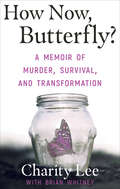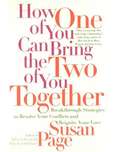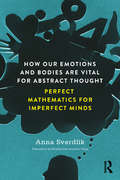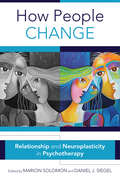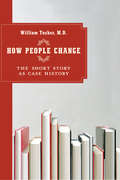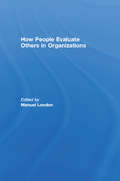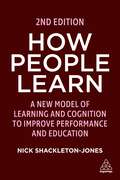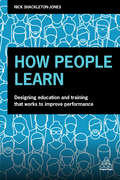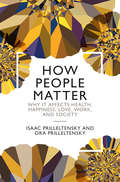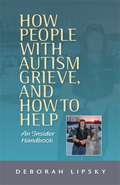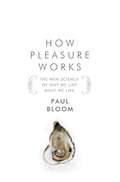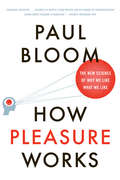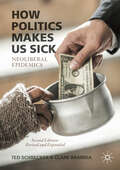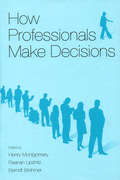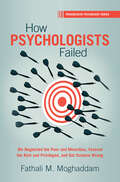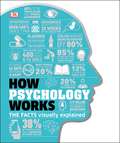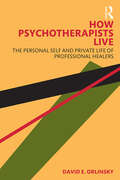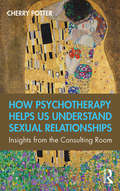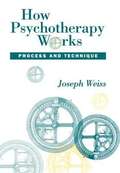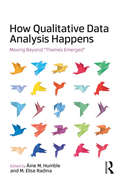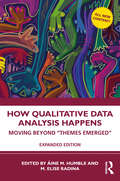- Table View
- List View
How Now, Butterfly?: A Memoir of Murder, Survival, and Transformation
by Brian Whitney Charity LeeA mother recounts her unthinkable experience after her thirteen-year-old son murders his little sister—and her struggle to emerge from devastation. Losing a young daughter to murder is the worst nightmare that a mother could possibly imagine—but what if the killer was her son? Charity Lee was thrust into this unimaginable situation when her thirteen-year-old son, Paris, murdered her beloved four-year-old daughter, Ella. Charity goes through intense grief at the loss of her daughter, while at the same time trying to understand why her son would have done something as horrific as this, and how she could have missed the signs that Paris was a true psychopath. While barely holding herself together throughout her intense grief, Charity is still a mother and feels a need to advocate for her son to receive appropriate treatment while incarcerated, while at the same time trying to ensure he stays in prison so he can never hurt someone again. Charity still loves her son and craves a connection with him despite all he has done. Because of her experiences, she rebuilds her life and starts a non-profit to help other families of victims, as well as offenders. This book is a meditation on grief, loss, and forgiveness unlike any other. It&’s also an inspirational story of a true survivor. How Now, Butterfly? is a haunting memoir that no reader will soon forget.
How One of You Can Bring the Two of You Together: Breakthrough Strategies to Resolve Your Conflicts and Reignite Your Love
by Susan PageSusan Page's groundbreaking approach to relationships gives readers the tools and encouragement they need to bring positive changes to their relationship, even when their partners are unwilling to do the work. Based on the premise that what you do in a relationship makes changes faster than anything you discuss, Page introduces the concept of "Loving Leadership" and offers fourteen empowering and doable strategies for recapturing the positive feelings, including how to:Overcome resentment and move beyond blameSolve major problems--one at a timeRecapture lost intimacyStep-by-step, Page demonstrates that with tangible goals, and new ways of thinking, one partner can bring new levels of harmony and love to a relationship.From the Trade Paperback edition.
How Our Emotions and Bodies are Vital for Abstract Thought: Perfect Mathematics for Imperfect Minds
by Anna SverdlikIf mathematics is the purest form of knowledge, the perfect foundation of all the hard sciences, and a uniquely precise discipline, then how can the human brain, an imperfect and imprecise organ, process mathematical ideas? Is mathematics made up of eternal, universal truths? Or, as some have claimed, could mathematics simply be a human invention, a kind of tool or metaphor? These questions are among the greatest enigmas of science and epistemology, discussed at length by mathematicians, physicians, and philosophers. But, curiously enough, neuroscientists have been absent in the debate, even though it is precisely the field of neuroscience—which studies the brain’s mechanisms for thinking and reasoning—that ought to be at the very center of these discussions. How our Emotions and Bodies are Vital for Abstract Thought explores the unique mechanisms of cooperation between the body, emotions, and the cortex, based on fundamental physical principles. It is these mechanisms that help us to overcome the limitations of our physiology and allow our imperfect, human brains to make transcendent mathematical discoveries. This book is written for anyone who is interested in the nature of abstract thought, including mathematicians, physicists, computer scientists, psychologists, and psychiatrists.
How Parties Experience Mediation: An Interview Study on Relationship Changes in Workplace Mediation
by Timea TallodiThis book presents an unprecedented qualitative research study on relational changes in mediation with a truly interdisciplinary outset, drawing on the literature on psychology, alternative dispute resolution and business. Mediation's potential to induce changes in parties' relationships as an advantage of the process is commonly mentioned in the literature. However, despite its being a key to reconciliation, relational changes in mediation has not yet been a topic of foundational and fine-grained qualitative enquiry. As the first study in the literature, this research uses in-depth interviews with mediation parties and the qualitative methodology of interpretative phenomenological analysis in order to explore participants' lived experiences. The phenomenological stance ensures a particularly rich data set and a nuanced interpretative analysis. This pioneering piece of research seeks to enter mediation parties' true experiences as closely as possible, moving beyond pre-existing theoretical, quantitative and large-scale qualitative explorations. The themes are discussed in the context of theory, research and practice. Therefore, this book advances knowledge about mediation both in theoretical and practical terms. Innovative conclusions and recommendations are provided for developing mediation practice, mediation training programmes, and further research.
How People Change: Relationships And Neuroplasticity In Psychotherapy (Norton Series on Interpersonal Neurobiology #0)
by Daniel J. Siegel Marion SolomonDrawing on cutting-edge neuroscience to understand psychotherapeutic change. Growth and change are at the heart of all successful psychotherapy. Regardless of one's clinical orientation or style, psychotherapy is an emerging process that s created moment by moment, between client and therapist. How People Change explores the complexities of attachment, the brain, mind, and body as they aid change during psychotherapy. Research is presented about the properties of healing relationships and communication strategies that facilitate change in the social brain. Contributions by Philip M. Bromberg, Louis Cozolino and Vanessa Davis, Margaret Wilkinson, Pat Ogden, Peter A. Levine, Russell Meares, Dan Hughes, Martha Stark, Stan Tatkin, Marion Solomon, and Daniel J. Siegel and Bonnie Goldstein.
How People Change: The Short Story as Case History
by William TuckerA manual to show practicing physicians and medical students how to make use of short stories to help their patients adapt to their illnesses and participate in their treatment. For most people, the quickest route to wisdom, other than experience, is through stories. Stories speak across generational lines and cultures, emphasize the universality of human experience, and offer insight into the dynamics involved in unfamiliar situations. Freud and D.W. Winnicott were among the few psychiatrists able to write case histories emblematic of the vicissitudes of the human condition. As a rule, the technical and dry approach of the psychiatric literature is not fit to teach doctors how to connect to their patients' suffering because it privileges pathological categories over experience. Tucker, therefore, turns to the drama and conflicts of fictional characters, to restore the human dimension of medicine and to entice practitioners to grasp the emotional and intellectual layers of the particular situations in which their patients are entrapped. The sixteen stories selected here are analyzed to show how they illustrate the process of change, as defined by Erik Erikson’s description of the "life cycle." Some of these stories include "Gooseberries" by Anton Chekhov, "The Dead" by James Joyce, and "Her First Ball" by Katherine Mansfield. Physicians and medical students can turn to these narratives as examples of how others have dealt with challenges and debilitating conditions, and encourage their patients to follow similar paths to bring about change in their lives.
How People Evaluate Others in Organizations (Applied Psychology Series)
by Manuel LondonEvaluating and making decisions about other people are key aspects of doing business, especially for managers and human resource professionals. Industrial and organizational psychologists devise systematic methods to remove human errors in judgment, such as biases and stereotypes. However many decisions about people are not made by experts using standard procedures. Even when they are, human judgment is unavoidable. This book examines the social psychological dynamics of person perception that underlie how people evaluate others in organizations. It contains original articles from leading experts in social, industrial, and organizational psychology. The book begins by examining basic principles and processes of social cognition and person perception, such as schemas, stereotypes, automatic/mindless information processing, the perceiver's motivation and affect, and situational conditions. It then applies these ideas to key areas of business operations. Helping readers understand and develop ways to improve the way people assess and make decisions about others, this book: * covers the interview, executive promotion decisions, and assessment centers; * examines performance appraisals and multisource (360 degree) feedback ratings; * addresses leadership cognitions, identifying training needs, coaching, and managing problem employees; and * includes chapters on cultural sensitivity, negotiations, group dynamics, and virtual teams.
How People Grow: What the Bible Reveals About Personal Growth
by Henry Cloud John TownsendAll growth is spiritual growth. Authors Drs. Cloud and Townsend unlock age-old keys to growth from Scripture to help people resolve issues of relationships, maturity, emotional problems, and overall spiritual growth. They shatter popular misconceptions about how God operates and show that growth is not about self-actualization, but about God's sanctification. In this theological foundation to their best-selling book Boundaries, they discuss:*?What the essential processes are that make people grow*?How those processes fit into a biblical understanding of spiritual growth and theology*?How spiritual growth and real-life issues are one and the same*?What the responsibilities are of pastors, counselors, and others who assist people in growing--and what your own responsibilities are in your personal growth
How People Learn: A New Model of Learning and Cognition to Improve Performance and Education
by Nick Shackleton-JonesHow can I design training so that it makes a real difference to employees' skills and development? This book gives L&D professionals everything they need to build effective learning experiences.How People Learn provides L&D professionals a new way of thinking about learning by exploring what happens when we learn. It shows how to apply insights from neuroscience, human behaviour and artificial intelligence (AI) to learning design including tips on how to interest, excite and engage staff in training. Using the author's '5Di model', this book demonstrates how to define, design and deploy training into existing workflows so it works both for and with employees. It also explores how simulations can be used to replicate a real-world challenge as closely as possible.The second edition features new material on learning in a hybrid world, and how to manage skills development and performance now that work, workplaces and workers have changed. It includes more practical guidance on building programmes with user-centred design and covers developments in the connection between learning and cognition, alongside case studies and examples from companies such as BP and the BBC.
How People Learn: Designing Education and Training that Works to Improve Performance
by Nick Shackleton-JonesWhat if we have been wrong about learning? Learning may have more in common with marketing than we thought. Looking at marketing and learning's common root, How People Learn shows L&D professionals a new way of thinking about learning by exploring what happens when we learn. It considers applications from AI, marketing and ethics and is informed by psychology and contemporary neuroscience in order to show L&D professionals how to design training with their employees and mind so that training makes a real difference to skills, capabilities, performance and development, rather than being a waste of time, money and resources. Using the author's '5Di model', How People Learn demonstrates how to define, design and deploy training in a user-centred way so it works both for and with employees. It also includes guidance on what training resources to create when employees are actively searching for learning content. Using this book, L&D practitioners will be able to use pull and push techniques to provide content that people use and experiences that transform their behaviour. From how to use simulations, storytelling and anticipation to the importance of observation and status, this book gives L&D professionals everything they need to build effective training programmes and learning experiences. With a forward by Dr Roger Schank, the Chairman and CEO of Socratic Arts and Executive Director of Engines for Education, and case studies from companies such as BP and the BBC, this is an urgent read for learning professionals.
How People Matter: Why it Affects Health, Happiness, Love, Work, and Society
by Isaac Prilleltensky Ora PrilleltenskyMattering, which is about feeling valued and adding value, is essential for health, happiness, love, work, and social well-being. We all need to feel valued by, and add value to, ourselves, others, co-workers, and community members. This book shows not only the signs, significance, and sources of mattering, but also presents the strategies to achieve mattering in our personal and professional lives. It uses research-based methods of change to help people achieve a higher sense of purpose and a deeper sense of meaning. Each chapter gives therapists, managers, teachers, parents, and healthcare professionals the tools needed to optimize personal and collective well-being and productivity. The volume explains how promoting mattering within communities fosters wellness and fairness in equal measure. By using the new science of feeling valued and adding value, the authors provide a guide to promoting happier lives and healthier societies.
How People Thrive: Promoting the Synergy of Wellness, Fairness, and Worthiness (Progressive Psychology)
by Isaac Prilleltensky Ottar Ness Salvatore Di Martino Michael P. ScarpaDiscover a groundbreaking perspective on personal and collective flourishing in this transformative book. Unveiling a dynamic synthesis of wellness, fairness, and worthiness, it presents a blueprint for thriving on personal, relational, occupational, systemic, community, and planetary scales. Move beyond the confines of individual well-being; embrace a holistic approach that encompasses entire groups, workplaces, communities, nations, and the world. While traditional psychology focused on personal thriving, the need for fostering the common good is now more urgent than ever-to combat pandemics, address climate change, champion peace, battle injustice, and elevate well-being globally. Dive into a compelling conceptual framework that guides theory, research, and action to tackle pressing global issues. This book pioneers a concise and powerful framework-three pillars of thriving: wellness, fairness, and worthiness. Join the movement towards a world where collective thriving is not just a goal, but a reality for all.
How People with Autism Grieve, and How to Help: An Insider Handbook
by Deborah LipskyThe book is an honest, first-hand account of how people with autism deal with the loss of someone in their life. Unlike the non-autistic response, people with autism, when faced with overwhelming or stressful situations, will favour solitude over sharing their emotions, tend to focus on special interests, and become extremely logical, often not expressing any emotion. This behaviour often leads to the belief that people with autism lack empathy, which is far from the case. Through the description of personal experience, and case studies, the book explores how people with autism feel and express the loss of a loved one, how they process and come to terms with their feelings of grief, and offers practical and detailed advice to parents and carers on a range of sensitive issues. These include clear instructions on how best to support someone with autism through the grieving process, how to prepare them for bad news, how to break the bad news, how to involve them in the funeral or wake, and how best to respond to later reactions. The final chapter explores the issue of why children and teens with autism can be drawn to death as a special interest, and explains that the interest is not normally a morbid one.
How Philosophy Changed Psychoanalysis: From Naïve Realism to Postmodernism (Philosophy and Psychoanalysis)
by Aner GovrinThrough this book, philosopher and psychoanalyst Aner Govrin demonstrates how psychoanalysis’ engagement with philosophy was crucial in the evolution of new psychoanalytic theories in three areas: perception of truth, developmental theories, and study of psychoanalytic treatment.Beginning with a Freudian perspective, through ego psychology to the intersubjective and the relational approach, Govrin shows that philosophy seeps into psychoanalytic theory itself, becoming a constitutive factor. When we discuss psychoanalysis, we cannot do it without reference to philosophy, since virtually every sentence it has generated harks back to and is embedded in philosophy. Moving onto the Post-psychoanalytic Schools Era in the second part, this seminal volume provides a model for understanding the evolution of psychoanalytic thought in the postmodern era, where “sensibilities” like the relational approach and infant research replaced the orthodox psychoanalytic schools. Govrin also explores whether psychoanalysis is a branch of philosophy, how psychoanalysis progresses, what a psychoanalytic innovation is, and why mainstream psychoanalysis rejects neuropsychoanalysis.Exploring the intricate relationship between psychoanalysis and philosophy, this book will be of interest to clinicians, scholars, teachers, and students of contemporary psychoanalysis across a broad spectrum of theoretical orientations, as well as those in philosophy of science, epistemology, and neuropsychoanalysis.
How Pleasure Works: The New Science Of Why We Like What We Like
by Paul BloomPleasure is anything but straightforward. Our desires, attractions, and tastes take us beyond the symmetry of a beautiful face, the sugar and fat in food, or the prettiness of a painting. In How Pleasure Works, Yale University psychologist Paul Bloom draws on groundbreaking research to unveil the deeper workings of why we desire what we desire. Refuting the longstanding explanation of pleasure as a simple sensory response, Bloom shows us that pleasure is grounded in our beliefs about the deeper nature or essence of a given thing. This is why we want the real Rolex and not the knockoff, the real Picasso and not the fake, the twin we have fallen in love with and not her identical sister. In this fascinating and witty account, Bloom draws on child development, philosophy, neuroscience, and behavioral economics in order to address pleasures noble and seamy, highbrow and lowbrow. Along the way, he gives us unprecedented insights into a realm of human psychology that until now has only been partially understood.
How Pleasure Works: The New Science Of Why We Like What We Like
by Paul Bloom"Engaging, evocative. . . . [Bloom] is a supple, clear writer, and his parade of counterintuitive claims about pleasure is beguiling."--NPR Why is an artistic masterpiece worth millions more than a convincing forgery? Pleasure works in mysterious ways, as Paul Bloom reveals in this investigation of what we desire and why. Drawing on a wealth of surprising studies, Bloom investigates pleasures noble and seamy, lofty and mundane, to reveal that our enjoyment of a given thing is determined not by what we can see and touch but by our beliefs about that thing's history, origin, and deeper nature.
How Politics Makes Us Sick: Neoliberal Epidemics
by Ted Schrecker Clare BambraThis book makes a powerful case that neoliberalism, the dominant economic and social policy paradigm of the post-1980 world, is hazardous to our health. It describes the destructive effects on health and health inequalities of neoliberal policies including labour market deregulation, welfare state retrenchment, and austerity, drawing on cross-national examples particularly from the United States and the United Kingdom. The book argues that a variety of adverse health outcomes, and in particular health inequalities, must be seen as ‘neoliberal epidemics’: neoliberal because they are associated with the rise of neoliberal politics; epidemics because they have been rapidly transmitted across borders at a rate seen in epidemics of biological contagions. The health case against neoliberalism has strengthened dramatically in the decade since the first edition was published and this fully updated and expanded edition provides a comprehensive overview of the main issues. Articulating alternatives that protect the health of people and planet is more urgent than ever. Crucially, the authors argue that neoliberal epidemics require a political cure in the form of a revitalised and equity-oriented social democracy.
How Professionals Make Decisions (Expertise: Research and Applications Series)
by Raanan Lipshitz Henry Montgomery Berndt BrehmerThis volume is the fruit of the 5th conference on Naturalistic Decision Making which focused on the importance of studying people who have some degree of expertise in the domain in which they make decisions. The substantive concerns pertain to how individuals and groups make decisions in professional and organizational settings, and to develop suit
How Psychologists Failed: We Neglected the Poor and Minorities, Favored the Rich and Privileged, and Got Science Wrong (Progressive Psychology)
by Fathali M. MoghaddamPsychology is a discipline with global influence, but continues to neglect disadvantaged minorities and continues to adopt an incorrect model of science. This volume explains what has gone wrong, and what steps should be taken for psychology to become a constructive international force. Historically, psychologists have focused only on causal explanations of behavior, neglecting normatively regulated behavior and intentionality. By giving greater importance to context and collective processes, moving from 'societies to cells,' psychologists can better understand and explain individual behavior. Poverty is an extremely powerful context that shapes cognitions and actions, with destructive consequences for disadvantaged individuals. The advocation of 'be happy psychology' and 'resilience' as solutions to problems faced by the disadvantaged leads to entrenched group-based inequalities, with the poor stuck at the bottom. Moving forwards, this volume proposes that psychologists should focus on normative systems to ultimately foster a more balanced field of study for the future.
How Psychology Works: Applied Psychology visually explained, First Edition
by Dorling Kindersley LimitedHow Psychology Works explains hundreds of psychological terms clearly and simply, such as neurosis, psychosis, psychopathy, self-efficacy, flow, human factors, and false memory syndrome.
How Psychotherapists Live: The Personal Self and Private Life of Professional Healers
by David E. OrlinskyHow Psychotherapists Live is a landmark study of thousands of mental health practitioners worldwide. It significantly advances our understanding of psychotherapists and counselors by focusing on their individual qualities and lives, revealing the many ways they differ as persons and how those differences shape their experiences of therapeutic work. Topics include the therapist's personal self, private life, individual beliefs, quality of life, childhood family experiences, and personal psychotherapy. Based on thirty years of research, the book is written to interest clinical practitioners while also providing researchers with a rich array of data. Clinical psychologists, psychiatrists, clinical social workers, and counselors can easily compare their own experiences with the thousands of therapists in the study by reflecting on typologies constructed from research findings. The book will also be a valuable resource for researchers studying the sources of variation in therapists' effectiveness.
How Psychotherapy Helps Us Understand Sexual Relationships: Insights from the Consulting Room
by Cherry PotterIn this fascinating book, Cherry Potter takes readers on her personal and professional quest for insights into sex, relationships and gender differences. Why do we feel what we feel, and do what we do? What is the impact of ‘performance anxiety’ on men, and on society generally? Why are women still faking it? Is ubiquitous online porn turning the clock backwards? The book delves into the work of Freud, Klein, Bowlby and recent developments in attachment theory for insights into our conscious and unconscious fears and desires, and introduces readers to a range of fascinating clients. These include Jeremy, who was so ashamed of his virginity he was unable to have a relationship; Ellie, who repeatedly fell in love with unobtainable men; Kieran, whose fear of abandonment threatened to wreck his gay relationships; Dulcie, who for years had been unable to face the truth that her husband was having multiple affairs; and Lars, who was addicted to online porn and prostitutes. The book shows how the work between therapist and client is a process of learning together, which is at times painful and deeply moving, but can also reflect a renewed vitality and hope for the future, particularly when it comes to talking about sex. How Psychotherapy Helps Us Understand Sexual Relationships: Insights from the Consulting Room will be of great interest to both the general reader as well as psychotherapists and counsellors.
How Psychotherapy Works: Process and Technique
by Joseph Weiss<P>In the landmark volume, THE PSYCHOANALYTIC PROCESS, Joseph Weiss presented a bold, original theory of the therapeutic process. Now, in HOW PSYCHOTHERAPY WORKS, Weiss extends his powerful theory and focuses on its clinical applications, often challenging many familiar ideas about the psychotherapeutic process. <P>Weiss' theory, which is supported by formal, empirical research, assumes that psychopathology stems from unconscious, pathogenic beliefs that the patient acquires by inference from early traumatic experiences. He suffers unconsciously from these beliefs and the feelings of guilt, shame, and remorse that they engender, and he is powerfully motivated unconsciously to change them. According to Weiss's theory, the patient exerts considerable control over unconscious mental life, and he makes and carries out plans for working with the therapist to change his pathogenic beliefs. He works to disprove these beliefs by testing them with the therapist. The theory derives its clinical power not only from its empirical origin and closeness to observation, and also from Weiss's cogent exposition of how to infer, from the patient's history and behavior in treatment, what the patient is trying to accomplish and how the therapist may help. By focusing on fundamental processes, Weiss's observations challenge several current therapeutic dichotomies--"supportive versus uncovering," "interactive versus interpretive," and "relational versus analytic." <P>Written in simple, direct language, Weiss demonstrates how to uncover the patient's unconscious plan and how the therapist can help the patient to carry out his plans by passing the patient's tests. He includes many examples of actual treatment sessions, which serve to make his theory clear and usable. The chapters include highly original views about the patient's motivations, the role of affect in the patient's mental life, and the therapist's basic task. The book also contains chapters on how to pass the patient's tests, and how to use interpretation with the patient. Dr. Weiss also provides a powerful theory of dreams and demonstrates how dreams can be utilized in clinical practice. <P>This distinguished volume is a major contribution that will profoundly affect the way one conceptualizes and practices therapy. Theoreticians, investigators, and clinicians alike will find it enlightening reading.
How Qualitative Data Analysis Happens: Moving Beyond "Themes Emerged"
by Áine Humble Elise RadinaWinner of the 2020 Anselm Strauss Award for Qualitative Family Research, National Council on Family Relations. How is qualitative data actually collected, analyzed, and accomplished? Real stories of How Qualitative Data Analysis Occurs: Moving Beyond "Themes Emerged" offers an in-depth look into how qualitative social science researchers studying family issues and dynamics approach their data analyses. It moves beyond the usual vague statement of "themes emerged from the data" to show readers how researchers actively and consciously arrive at their themes and conclusions, revealing the complexity and time involved in making sense of thousands of pages of interview data, multiple data sources, and diverse types of data. How Qualitative Data Analysis Occurs focuses on a diversity of topics in family research across the life course. The various authors provide detailed narratives into how they analyzed their data from previous publications, and what methodologies they used, ranging from arts-based research, autoethnography, community-based participatory research, ethnography, grounded theory, to narrative analysis. Supplemental figures, images, and screenshots which are referred to in the chapters, are included in an accompanying eResource, as well as links to the previously published work on which the chapters are based. This book is an invaluable resource for experienced and novice qualitative researchers throughout the social sciences.
How Qualitative Data Analysis Happens: Moving Beyond “Themes Emerged”
by Áine M. Humble M. Elise RadinaHow Qualitative Data Analysis Happens: Moving Beyond “Themes Emerged”, offers an in-depth look into how qualitative social science researchers studying a wide range of human experiences and dynamics approach their data analyses. This expanded edition consists of 13 new chapters from a broad range of disciplines (and an added conclusion) that document the stories about how qualitative data analysis occurred.Chapters for this expanded edition represent a diversity of disciplines (e.g., criminology, family science, education, health, nutrition, sociology, sport psychology) that focus on the human experience and describe a diversity of methodological approaches. These chapters may be used to introduce readers to newer or innovative ways of analysing data. It moves beyond the usual vague statement of “themes emerged from the data” to show readers how researchers actively and consciously arrive at their themes and conclusions, revealing the complexity and time involved in making sense of thousands of pages of interview data, multiple data sources, and diverse types of data. The various authors provide detailed narratives into how they analysed their data from previous publications. The methodologies range from arts-based research, autoethnography, community-based participatory research, ethnography, grounded theory, to narrative analysis. The volume allows readers to be seemingly “in the room” with these international scholars (representing Canada, the US, Austria, Germany, the UK, and the Philippines) and getting their own hands vicariously dirty with the data.This expanded edition also includes a conclusion chapter, in which the authors reflect on commonalities across the chapters. Supplemental figures, images, and screenshots, which are referred to in the chapters, are included in an accompanying eResource (that can be accessed at www.routledge.com/ 9781032183213), as well as links to the previously published work on which the chapters are based. This book is an invaluable resource for experienced and novice qualitative researchers throughout the social sciences, as well as undergraduate and postgraduate students in the field.
